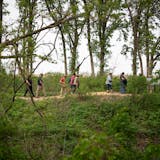Doctors in Minnesota expect that they'll again be using a COVID-19 vaccine manufactured by Johnson & Johnson within a few weeks, so long as troubling new safety reports from recipients don't emerge in the coming days.
But even if it returns soon, the vaccine likely will face perception problems after it was temporarily pulled from circulation last week after several patients reportedly suffered side effects involving a rare and dangerous blood clot issue.
While exceedingly uncommon, the clotting is concerning because of the serious patient risk as well as its similarity to rare side effects that surfaced with a COVID-19 vaccine used in Europe. Health officials hope collecting better data on the risk will help rebuild confidence in the single-dose vaccine, which they've been counting on to quicken the pace of vaccinations and protect groups who otherwise might miss out on immunizations.
"Will we be using the vaccine again? Yes, I think certainly so," said Dr. Gregory Poland, a vaccine immunology specialist at Mayo Clinic. "It is an effective and it's an overall safe vaccine, and has the big value of a single dose."
The number of people who have experienced clots after receiving a Johnson & Johnson vaccine is so small — six people out of nearly 7 million vaccine recipients — that some might question whether the pause is necessary, said Poland, who supports it. Consequences from temporarily pulling the vaccine from use are limited, he added, because COVID-19 immunizations are continuing with vaccines in wider use from Moderna and Pfizer, products where safety questions haven't emerged.
"This is a demonstration that the vaccine safety surveillance system that we have in the U.S. picks up risks even this small — one in a million," Poland said.
State hits 7,000 deaths
Minnesota reported 2,429 new coronavirus cases and 10 more deaths linked to COVID-19 on Saturday, pushing the statewide pandemic death toll past 7,000.
The milestone comes as the rolling seven-day average for deaths declined last week, according to the Star Tribune's coronavirus tracker. The seven-day average for net new cases was up from one week earlier but down from the previous two days.
![Three weeks ago, Octavio Rodriguez switched from making transmission parts to casting parts for hospital bed brake assemblies at Twin City Die Castings. ] GLEN STUBBE • glen.stubbe@startribune.com Thursday, April 9, 2020 How employee-owned Twin City Die Casting, which just laid off 40 production workers of its 250 employees in what was supposed to be a good year, is trying to accelerate its pivot to growing medical parts business for ventilators, hospital beds, etc as it copes with instan](https://arc.stimg.co/startribunemedia/WNZYKGTZ5IYMUCO3KI5TR3N7WI.jpg?&w=80&ar=1:1&fit=crop)

djoles@startribune.com As boaters flock to Minnesota lakes and rivers this holiday weekend for the unofficial kick-off to the boating season, they'll face more inspections in and out of the water as local cities and counties ramp up their work to stop the spread of invasive species. Across the metro, more boat accesses will be staffed by watercraft inspectors thanks to $10 million funneled to county government programs this year, up from $4.5 million the state allocated last year. ORG XMIT: MIN1505222156290209 ORG XMIT: MIN1506021218440580](https://arc.stimg.co/startribunemedia/34QSKO44B2XKVNUZCO5SLJQSLY.jpg?&w=80&ar=1:1&fit=crop)
